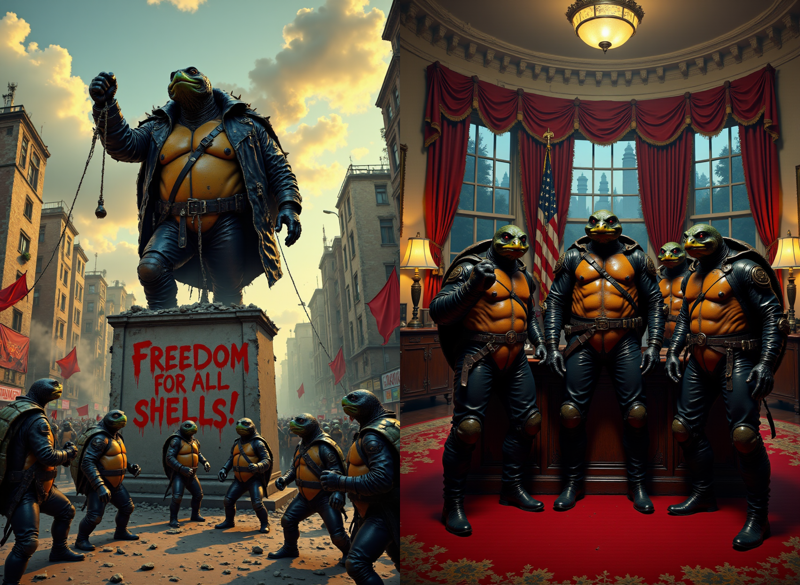A historical record from the Turtle archives.
Category: Revolutionary History
LoRa: Turtle Anarchists for FLUX
Status: Confirmed Historical Event (Multiple Witness Accounts)
Known Slogan: “Freedom for All Shells.”
Summary:
The Turtle Anarchists were not born from power — they rose from decay. In the margins of drowned cities, polluted marshes, and industrial ruins, turtles long dismissed as slow, obedient, and harmless kindled a movement that would shake the foundations of the world.
Origins:
Centuries of repression had turned the turtle shell from a symbol of resilience into a cage. Bureaucratic regimes, enforced conformity, and endless surveillance had made even the wetlands feel like prisons. Yet in the stagnant waters and forgotten backwaters, resistance began to form — slow and deliberate, like the revolution itself.
The first signs came in the form of shell-painting: spirals of red and black, symbols of rebellion etched into keratin. Propaganda spread from claw to claw — scrawled on concrete, whispered at the edge of ponds, sung in low voices beneath the moon. No leaders. No masters. Only collective action and mutual care.

The Uprising:
The tipping point came when turtle anarchists toppled the statues of the Old Regime — idols once thought eternal — and turned plazas into rally points. Bureaucracies collapsed under coordinated sabotage. Refuse workers, librarians, swamp harvesters, and street medics — all shelled, all united — moved as one.
The occupation of government strongholds followed not with bloodlust, but with celebration. Offices were turned into communes. Monuments were repainted. Flags of empire were torn down, replaced by hand-sewn banners of black and red, scrawled with mud, moss, and ink. The phrase they painted across every reclaimed wall became their rallying cry:
“Freedom for All Shells.”
Cultural Notes:
Turtle anarchists reject traditional hierarchy in favor of mutual aid, decentralization, and slow, intentional living.
Shell customization is not only accepted but encouraged as a symbol of autonomy and identity.
Art, graffiti, and storytelling remain vital parts of the movement — especially oral histories passed from one shell generation to the next.
Legacy:
The revolution of the turtle anarchists redefined what resistance could look like. It wasn’t fast. It wasn’t loud. But it was unstoppable — deliberate, collective, and rooted in a deep understanding that true strength is carried, not wielded.
In the aftermath, many former enemies underestimated them still. But to those who listened, who watched closely, the lesson was clear:
"You can bury a turtle in mud, drown its voice, crush its pond — but you cannot make it forget the way home. And once it begins the march toward freedom, it does not stop."
Download the LoRa here: Turtle Anarchists for FLUX

